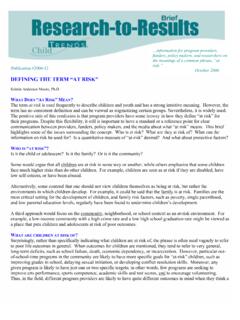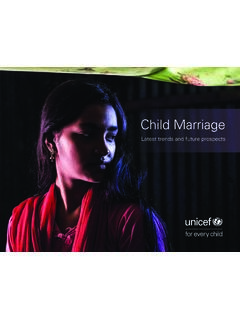Transcription of OECD FAMILY DATABASE, oe.cd/fdb 1
1 OECD FAMILY Database OECD - Social Policy Division - Directorate of Employment, Labour and Social Affairs 1 Updated: 13-07-2018 : child poverty Definitions and methodology This indicator presents data on child income poverty through three main measures: i) The child relative income poverty rate, defined as the percentage of children (0-17 year-olds) with an equivalised household disposable income ( an income after taxes and transfers adjusted for household size) below the poverty threshold.
2 The poverty threshold is set here at 50% of the median disposable income in each country. ii) poverty rates in households with children, by type of household, that is, the proportion of individuals in households with a working age (18-64 year-old) head and at least one child (0-17 year-olds) with an equivalised household disposable income below the poverty threshold, again set at 50% of the median disposable income in each country. The household types used here are single adult with at least one child and two or more adults with at least one child .
3 Iii) poverty rates in households with children, by household employment status, that is, the proportion of individuals in households with a working age (18-64 year-old) head and at least one child (0-17 year-olds) with an equivalised household disposable income below the poverty threshold, again set at 50% of the median disposable income in each country. The household employment statuses used are jobless (that is, no working age adult in the household is in paid employment) and working (where at least one working age adult in the household is in paid employment).
4 In all cases income is based on equivalised household disposable income. Income includes both market earnings and income from capital, and is presented net of all direct taxes and social security contributions paid by, and government transfers received by, the household. Equivalised household incomes are used because all members of a given household are assumed to pool and share earned income. The square root scale is used to equivalise household income. Key findings On average across OECD countries, of children live in relative income poverty (Chart ), albeit with rates differing considerably from country to country.
5 In four OECD countries (Chile, Israel, Spain, and Turkey) more than 20% of children live in relative poverty , with rates particularly high at more than 25% in Israel and Turkey. In contrast, in nine other OECD countries (Austria, Denmark, Finland, Iceland, Korea, Norway, Slovenia, Sweden, and Switzerland) less than 10% of children live in relative income poverty . In Denmark and Finland, the child relative income poverty rate is only around 3-4%. In many OECD countries children are slightly more likely to live in income poverty than the general population (Chart ).
6 Relative poverty rates for children are higher than poverty rates for the total population in 28 of the 36 OECD member countries, with the gap between the average rates for the two groups just under two percentage points. However, in eight OECD countries (Denmark, Estonia, Finland, Korea, Latvia, Norway, Slovenia, and to a lesser extent Sweden) children are less likely to live in relative income poverty than the general population. In Korea, the child relative income poverty rate is almost seven percentage points lower than the relative income poverty rate for the whole population.
7 Other relevant indicators: : trends in income inequality and the income position by household type; : Children in sole-parent families and : Children in families by employment status. OECD FAMILY Database OECD - Social Policy Division - Directorate of Employment, Labour and Social Affairs 2 Updated: 13-07-2018 Chart child relative income poverty rate, 2015 or latest available year Relative income poverty rate (%), for the total population and for children (0-17 year-olds) Note: Data are based on equivalised household disposable income, income after taxes and transfers adjusted for household size.
8 The poverty threshold is set at 50% of median disposable income in each country. Data for China, India and the Russian Federation refer to 2011, for Japan to 2012, for Brazil to 2013, and for Australia, Hungary, Iceland, Mexico and New Zealand to 2014. a) The statistical data for Israel are supplied by and under the responsibility of the relevant Israeli authorities. The use of such data by the OECD is without prejudice to the status of the Golan Heights, East Jerusalem and Israeli settlements in the West Bank under the terms of international law.
9 Sources: OECD Income Distribution Database Despite considerable efforts and the introduction across OECD countries of policies aimed at reducing child poverty , child relative poverty rates are increasing in several OECD countries. Chart shows child relative income poverty rates in 2004, 2009 and 2015 (or latest available). Between 2004 and 2015, child poverty rates increased in 13 of the 20 OECD countries with available data, and in some the increase was large. In Spain and the Slovak Republic, for instance, the child relative poverty rate grew by about four percentage points beween 2004 and 2015, while in Greece it rose by over six percentage points.
10 In the remaining seven OECD countries with available data, child relative income poverty rates fell between 2004 and 2015. The largest declines were in Ireland, where the it declined by about 5 percentage points, and in Poland, where it fell by just under 10 percentage points. Chart child relative income poverty rates, 2004, 2009, and 2015 or latest available year Relative income poverty rate (%) for children (0-17 year-olds) Note: Data are based on equivalised household disposable income, income after taxes and transfers adjusted for household size.













